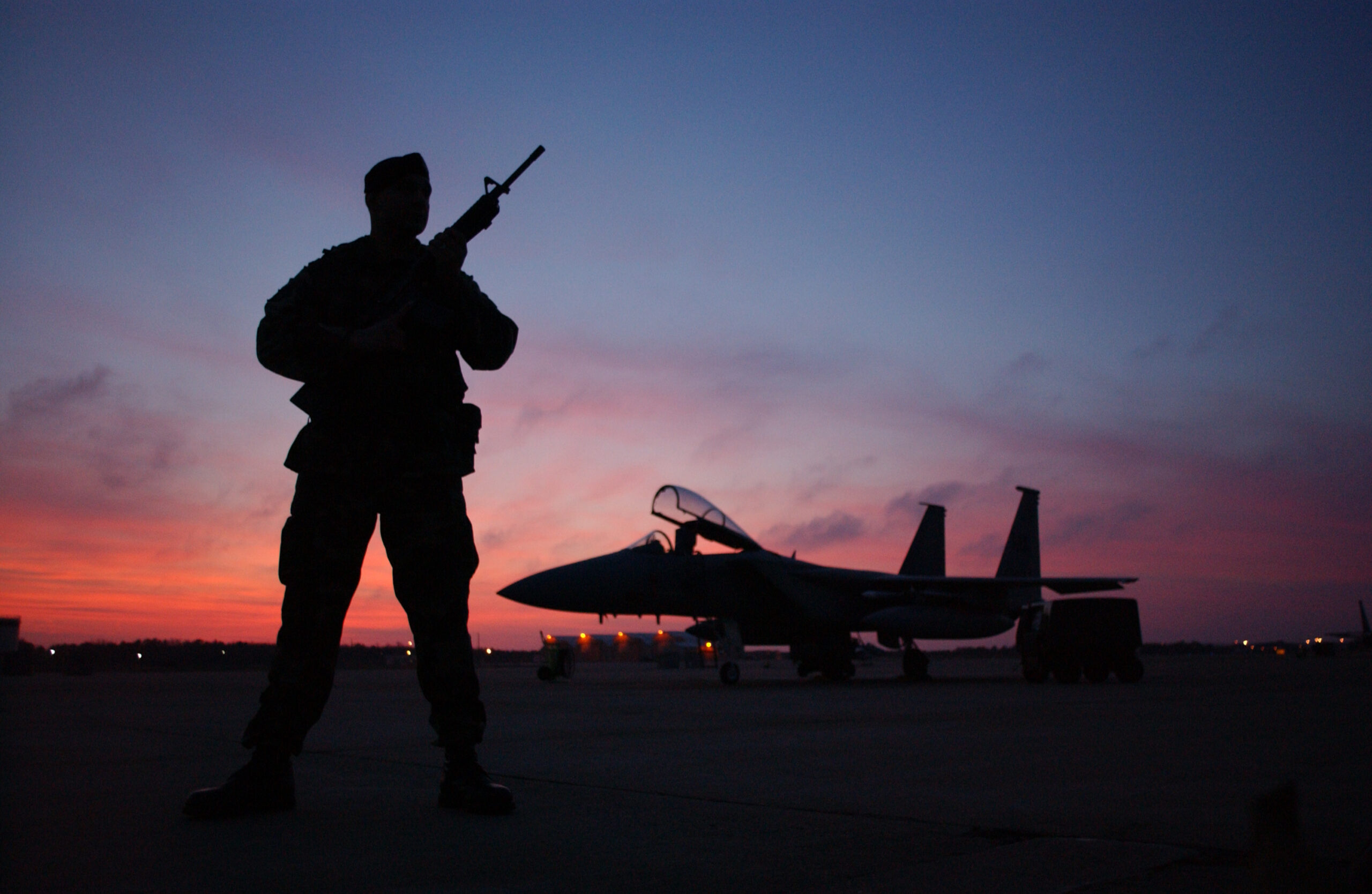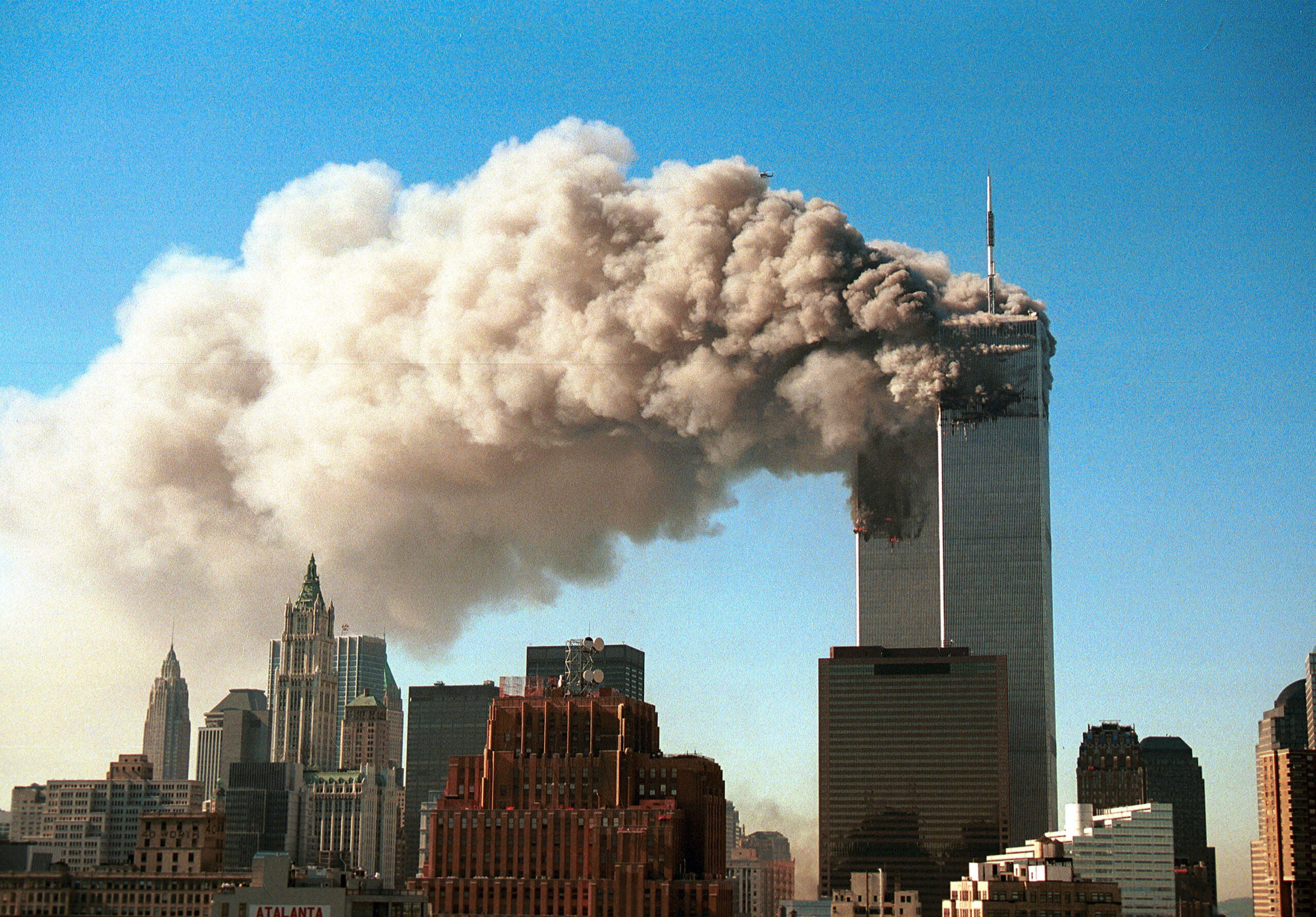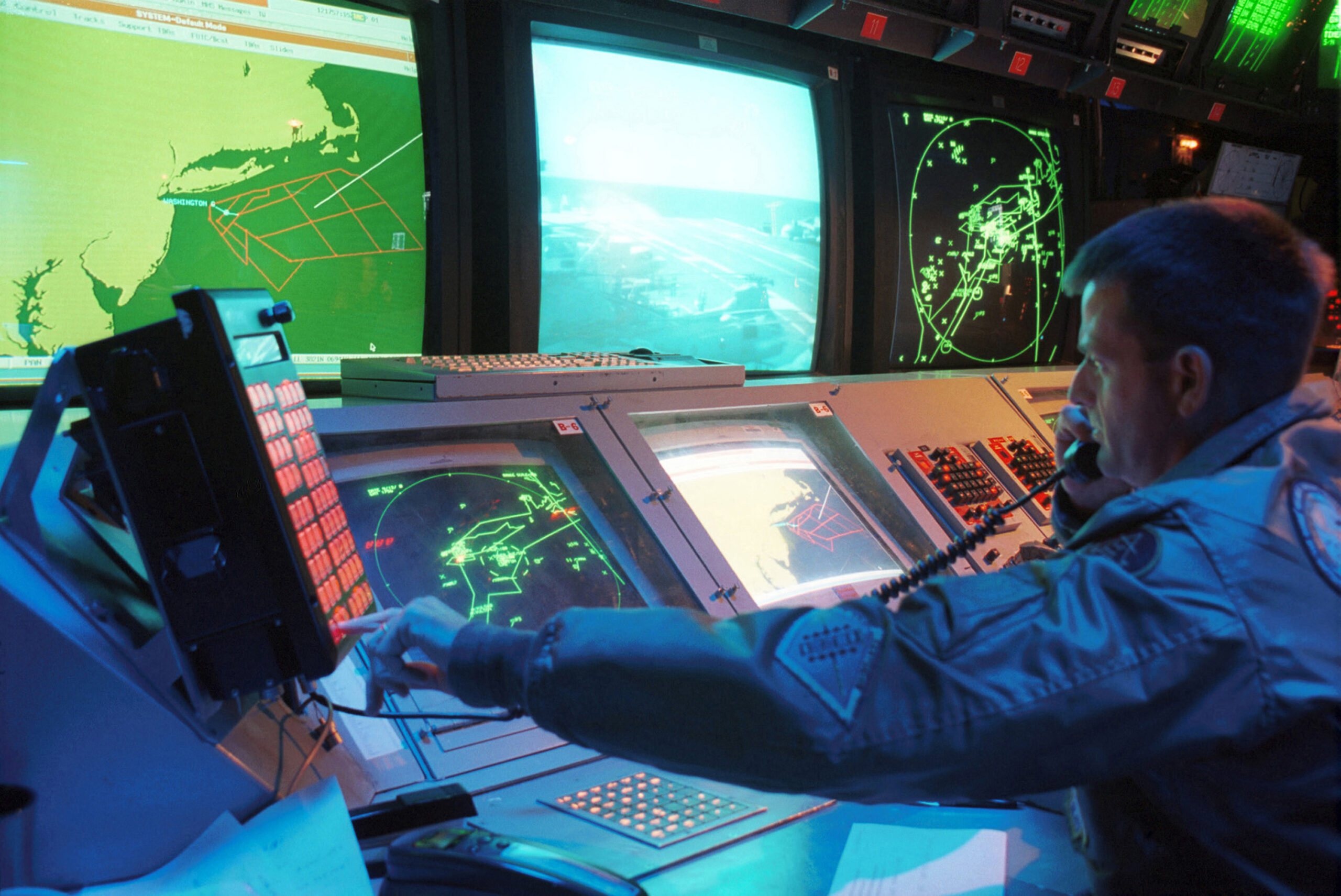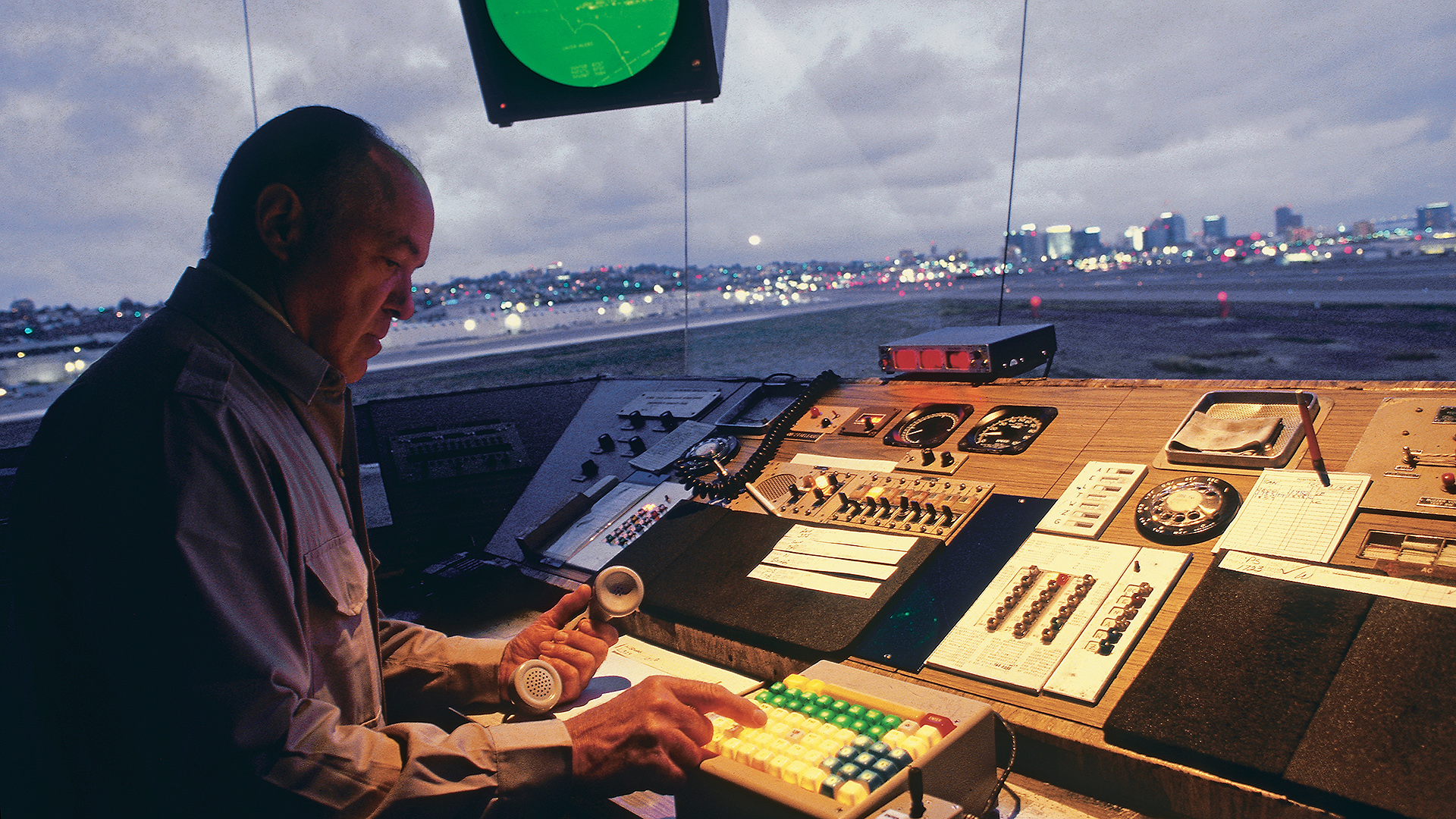Colin Scoggins, retired air traffic controller and Federal Aviation Administration liaison to the military, typically left for his shifts at the Boston Air Route Traffic Control Center by about 7:30 in the morning. While employees were allowed a three-hour flex window from six to nine in the morning to make it to work, Scoggins recalls the weather being so serene on Tuesday, September 11, 2001, that he decided to take his time brewing a cup of coffee and enjoying it on the porch once his wife and kids had left for the day. He’d eventually start his commute at 8 a.m. and arrive on site about 25 minutes later, completely unaware of the situation he was about to walk into.
“As soon as I came in the front door, someone came up to me and told me they had a highjacking going on on the floor,” said Scoggins. “My office was upstairs to the right of the credit union, so I went upstairs and stopped there real quick, said hello to the girls that worked there, and went right to my office and called Dan Bueno down on the floor who was the traffic management supervisor at the time.”

Bueno urged Scoggins to hurry downstairs and join him on the floor, revealing that acts of violence had been reported on American Airlines Flight 11. At this point, Boston Center wasn’t as acutely aware of the situation as it would later become. Violence on a highjacked jetliner, however, was more than enough to prompt Bueno to call the Otis Air National Guard base in Cape Cod in hopes of getting some fighters in the air to escort the plane. Scoggins advised that he goes straight to the top instead.
“I told him, no, you got to call the Northeastern Air Defense Sector [NEADS],” Scoggins said. “So, when I hung up, he had a colleague named Joe Cooper call NEADS. That was probably at about 8:37 or something. But before I went downstairs, I had made two calls myself to the airspace manager over at NEADS as well. Then I immediately went downstairs and spent the next 12 hours pretty much locked in down there.”

Before the full extent of the situation was even understood, Scoggins, Bueno, and fellow Boston Center air traffic controllers were already having to jump through procedural hoops to ensure that the right reports were making their way to the right people. In a scenario that later proved to be one of the most dire in aviation history, having to relinquish minutes of time to playing phone tag with the military understandably made it difficult for Scoggins and his fellow air traffic controllers to do their jobs in a timely manner.
Another factor was preparation and protocol. While the men and women working at Boston Center during these events were undoubtedly skilled in their roles, the Federal Aviation Administration (FAA) and the rules it follows and implements exist on a pre-and-post 9/11 timeline. The FAA underwent an unprecedented evolution following 9/11, one that actually began that very day when the agency helped completely shut down U.S. airspace in an act that had never before been executed before. Essentially, both Scoggins and Boston Center would have a hand in altering the trajectory of the FAA and how it operates — they just didn’t know it yet.

“There was no training to be the military liaison,” Scoggins said. “They either call you the military liaison or the military specialist. Each center is supposed to have one, and there are 21 centers in the country. Twenty-three if you consider Puerto Rico and Hawaii, and there is no training. You just kind of learn from what you’ve done in the past.”
It is important to note here that Scoggins is specifically referring to training for his role as the FAA’s military liaison for Boston Center, not as an air traffic controller (ATC). ATCs go through extensive training, as Scoggins explained to The War Zone in a past feature discussing his career.
“The closest thing to training that I did have [as military liaison] was writing the military’s letters of agreement between our facility and them,” Scoggins continued. “Now, I also worked in civilian airspace and procedures, so I had my own civilian letters of agreement training, but most of what you used was past experience. I came from an area that had a lot of military work, and I was in the military myself, but mainly I just used my prior knowledge of writing military letters of agreement and airspace procedures since 1995, like how to reserve and activate military airspace for example.”

By 2001, with only his ATC training and personal experience with military procedures, Scoggins considered himself to have a pretty good handle on things. He would even say the same about his role on September 11, explaining that by the time the plane hit the second tower at the World Trade Center, he was sure the country was under attack by terrorists. However, he was only one person in what was an extensive chain of command, and up until that point, he describes a lot of bureaucracy and uncertainty.
“The way procedure is supposed to happen is like this:” Scoggins began. “The controller has a hijack, he tells his supervisor, his supervisor tells the OMIC [Operations Manager In Charge], the OMIC then does two things. He’s supposed to call the regional call center and tell them he has a hijack. The call center then gets in touch with the command center and the hijack coordinator at FAA headquarters. Now the hijack coordinator is going to call his hijack counterpart at the National Military Command Center. The NMCC is going to call the [Northeast Air Defense Command], then NORAD is going to turn around and call the regional defense sector that is responsible for the area. So right away you can see how detailed this process is.”

Scoggins being the military liaison for Boston Center, however, meant he had a direct hotline to the NEADS, which in the long run could have provided the FAA with more time to try and respond to the situation than they would have been allowed originally. Unfortunately, though, the hijack coordinator at the FAA was in Puerto Rico with no one to cover his shift at the time the call was made, so the transfer of intel stopped there. But Scoggins and his colleagues persisted.
“As information started coming in about the hijackings, our first thought was to get fighters in the air,” Scoggins said. “Unfortunately, there are a lot of conspiracy theorists out there that think as soon as a plane misses a frequency change that we should be launching fighters, but that’s not the way it works. Even the procedures for a hijack back in 2001 were for fighter jets to just get five to 15 miles behind the aircraft and escort it. There were no interdiction procedures written up at that time.”

Scoggins also divulged that Boston Center didn’t have a scramble circuit in 2001, which he described as a phone with no dialing numbers that would ring the alert barn at Otis Air Force Base where two alert aircraft were kept at all times to be scrambled as needed. While Boston Center has since been connected to the base, this hotline wasn’t available to them at the time, preventing them from reaching out to Otis and receiving scramble information directly.
“Because of this, when they call up and start giving authentication numbers, we never hear any of that. We just get told by Otis tower that they’re requesting to launch two fighters, and that’s the first indication we get,” Scoggins added. “For the 9/11 flights, it was the other way around, and we were trying to contact them. Actually, Bueno’s first error was calling Otis instead of NEADS, which only happened because this wasn’t something we did all the time. The last hijack we had was in 1993.”

At this point, neither the Northeast Air Defense Sector nor Otis had gotten any fighters in the air yet, which is a part of this story that Scoggins to this day is disappointed about. Even though he himself had made a couple of calls to NEADS as soon as he arrived that day and was briefed on the situation, and his colleague Joe Cooper had been directed to make a call to the sector as well, final orders had yet to come down from the top.
“Otis tower knew something was going to happen because Danny Bueno had called them first thing that morning,” Scoggins said. “But they were waiting for the call from NEADS because they can’t scramble without those authentication numbers.”
The entire time that communications were being shared back and forth, American Airlines Flight 11, American Airlines Flight 77, United Airlines Flight 175, and United Airlines Flight 93 continued progressing on their flight paths. American 11 in particular, was just minutes away from crashing into the World Trade Center’s North Tower. Scoggins once again got a hold of NEADS and alerted them of the plane’s current location in hopes of finally scrambling some fighters, but they asked for American 11’s transponder code instead.

“I said he doesn’t have a code anymore he turned his transponder off. So we’re going back and forth, and they won’t launch fighters until they know where the aircraft is,” Scoggins said. “This is probably one of the discrepancies in the way the system was run back then because if they were to take off without the hijacked plane’s location we could easily just vector them and send them where they needed to go.”
At 8:46 a.m., after speaking with Scoggins and using the latitude and longitude information he provided them to pinpoint the plane’s location, NEADS finally ordered the launch of two F-15 alert aircraft from Otis Air Force Base 153 miles away from New York City. NEADS then called NORAD to relay the information.
Forty seconds later, American 11 crashed into the World Trade Center’s North Tower.

“At first, we didn’t even know American 11 had hit the tower,” Scoggins said. “We got a report about two minutes later that a small aircraft had hit the tower. So they still put the fighters in warning area 105, and they were holding there for a few minutes, and then the second tower was hit. I immediately started making tons of phone calls to NEADS, but at the same time, I didn’t want to step on their toes because I figured they must be getting swamped. Turns out they weren’t.”
Scoggins and Boston Center then became the point of contact for NEADS and NORAD, providing them with information that the FAA’s New York Center apparently hadn’t by that point. He learned that both commands never found American 11 before it was revealed to be the plane that crashed into the North Tower, and neither the military nor Boston Center knew what it needed to about United 175 before it was too late.
“I do believe there were controllers at Boston Center that knew the aircraft got hijacked and just didn’t pass the information up the chain of command quick enough,” Scoggins said.

Miscommunications between the FAA, NORAD, and NEADS only proliferated throughout the day as fears grew and the threats facing the country continued to deviate further and further from any procedure or plan that ATCs at the time had ever trained with. But by the time Boston Center became aware of the situation unfolding aboard United 93, Scoggins wasn’t going to take any chances.
“If a plane didn’t answer you correctly, we assume the aircraft has been hijacked. So, we have Delta Flight 1989, and he misses his frequency swap to Cleveland, so, right away we think hijack,” Scoggins said. “I call up NEADS and tell them there’s another possible hijack and also call up Cleveland Center. NEADS somehow calls me back and asks if it’s instead Delta 89 which didn’t even exist, so then the callsign gets misconstrued, and now they think two more planes have been hijacked. At the same time, United 93 is actually getting hijacked.”
Scoggins admits to this mistake, but NEADS had already deployed F-15s from Ohio and Michigan to intercept and escort Delta 1989 back to Cleveland while United 93 had turned off its transponder and continued flying. At the same time, Indianapolis Center was dealing with the fact that American 77 had just crashed into the Pentagon without anyone from FAA headquarters ever having asked for military assistance. The passengers on United 93 eventually banded together to try and stop the hijacking at around 10 a.m., causing the plane to go down in a field near Johnstown, Pennsylvania. No one aboard any of the four flights hijacked on September 11 survived.

This is no fault of Scoggins’, Bueno’s, Cooper’s, or anyone at Boston Center directly as these people went into work that day completely unbeknownst to the tragedy that would unfold and did all that they were trained to do in spite of the panic and confusion everyone was surely feeling. Scoggins is just grateful that the federal government’s response to the September 11 terrorist attacks prompted the systematic changes that it did.
“I will say this, on that day, there’s something called the Domestic Event Network (DEN line) that we used, and that phone line has never been hung up since 9/11. That phone line is on 24/7, and all of the centers are on it, most major approach controls are on it, the FBI is on it, Homeland Security is on it, TSA is on it. If something happens, we could put a ground stop out so fast it would definitely help circumvent the process,” Scoggins assured, and that has happened since. “But I have to say, the biggest thing is that I know our passengers are never going to let anyone successfully hijack a plane ever again.”
Thank you to Colin Scoggins for taking the time 21 years later to recount his unfathomable experience on Tuesday, September 11, 2001.
Contact the author: Emma@thewarzone.com
